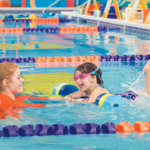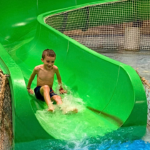Sharing is caring!
Having spent more than a decade working with children, I understand that kids are not always equal; students who are the same age vary widely in levels of fear and confidence as well as in their cognitive and motor functions. The American Psychological Association notes that children’s brain functions do not always develop at the same pace. Verbally-endowed children may take longer to gain coordination, and children with well-developed motor skills may not be as socially mature. So, don’t worry too much about how your child compares to others in age. Instead, try to focus on your child’s individual progress and address any difficulties as they arise.
Negative Associations with Water
If your child had a frightening experience in the water at any time during their childhood, they might be faced with major setbacks when they attend swimming lessons. According to the American Academy of Child and Adolescent Psychiatry (AACAP), trauma like this can affect a child for months or years into the future. The psychological damage may reveal itself through PTSD symptoms such as reliving the experience, becoming frightened, agitated by reminders of the experience or dealing with headaches and stomach pain.
On the other hand, if you spend time playing gently with your child in a backyard pool, at the beach, or even in the bathtub, you’ve already laid the groundwork for an easy transition into swimming lessons. Building this positive association with water is key to swimming success, especially in young children. I find that students who see the water as a pleasant place are more willing to try new skills while students who are fearful take longer to adjust to the new environment and may take months or years longer to learn to swim on their own.
Lack of Motor Skills
Children who are four or younger are at a bit of a disadvantage because they’ve had less time to hone their motor function than older kids. The National Association for the Education of Young Children (NAEYC) recommends encouraging your child to perform an array of activities on their own to promote strength and coordination. Things like pouring juice, getting dressed, finger painting and opening and closing containers are all excellent ways to start developing hand-eye coordination as well as physical strength. The NAEYC also recommends ‘big body’ play like chasing friends and climbing on furniture to help build up larger muscles groups and increase bodily awareness in children. Gross and fine motor skill function are imperative to learning to swim, so let your child complete tasks on their own and you’ll see marked improvement in their ability to perform essential swimming skills like gripping the poolside, coordinating arm and leg movement, and controlling their head position.
Crying to Get Their Way
If your child’s crying makes lesson-time fruitless, consider the cause of their upset. If they’ve never had a bad experience in the water, and if they’re three or older, they may just be trying to provoke a reaction from Mom or Dad. Most kids have come to recognize that crying gets them special attention and, often, a way out of doing something they don’t feel like doing. Thanks to a naturally-occurring hormone called oxytocin, parents experience a neurological response to the sound of their baby crying and feel an innate urge to find and comfort the child. Researchers at New York University’s Langone School of Medicine found that oxytocin causes maternal reactions, especially when in proximity to their crying child. This natural defense mechanism once protected children from the harsh realities of the natural world: hunger, predators, etc., but in our current world, it creates a loophole for children to manipulate their way out of situations they find unpleasant.
When it comes to necessities like learning to swim, crying to get out of lessons is something you must learn to work through as a parent. I find that a crying child often calms down when their mom or dad leaves the pool deck and remains out of sight for the duration of the lesson. Handing the reigns to the instructor can be difficult, but it’s absolutely essential if your child is putting on a show for you. If you’re not sure if the tears are real or not, talk to the swimming teacher. Not only is it easier emotionally for a hired swim instructor to do the teaching, it’s also easier for them to judge the child’s reaction and separate authentic fearfulness from crying to get out of lessons.
If your child is not progressing as quickly as you’d like, there’s no reason to believe that they’re incompetent or incapable. The reasons for not advancing at the same rate as other students are many and varied: previous experience with water, mastery of motor skills, and the child’s bond (or lack of) with the instructor are all important factors in learning (or not learning) to swim. If your child is moving through skills very slowly, speak with your instructor about why this is the case. They may just need some personalized attention in a specific area.
About the Author
 This article was written by Lizzy Bullock, a WSI-certified Red Cross swimming instructor with over 10 years of experience teaching infants, children, and adults how to swim. Lizzy currently works as a swimming instructor and staff writer for AquaGear, a swim school and online shop
This article was written by Lizzy Bullock, a WSI-certified Red Cross swimming instructor with over 10 years of experience teaching infants, children, and adults how to swim. Lizzy currently works as a swimming instructor and staff writer for AquaGear, a swim school and online shop
Erin Huiatt
Erin is a reliable resource and stepping stone for women and families to find support and make connections within our community. She wants families to feel confident to reach out and ask for help and advice to get pointed in the right direction. She enjoys traveling and exploring with her two children in tow!







